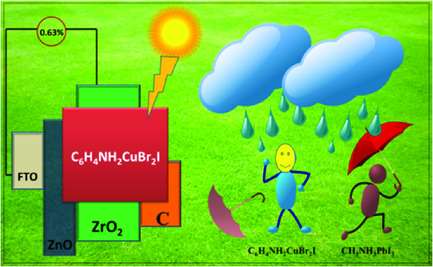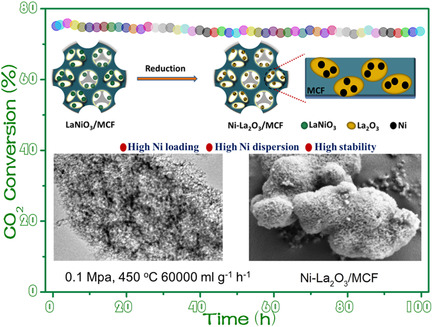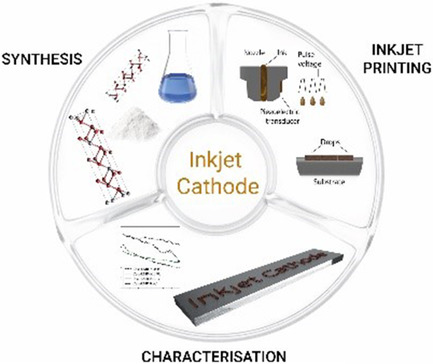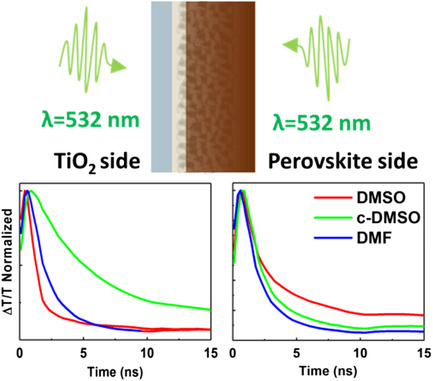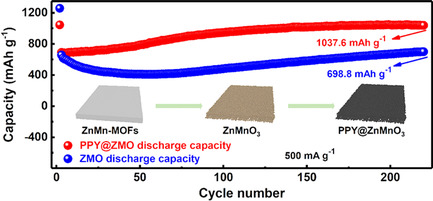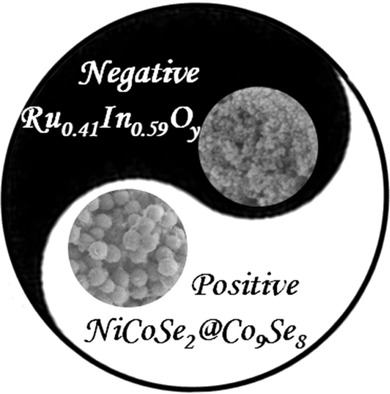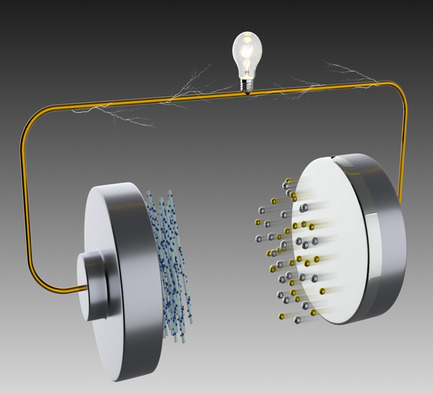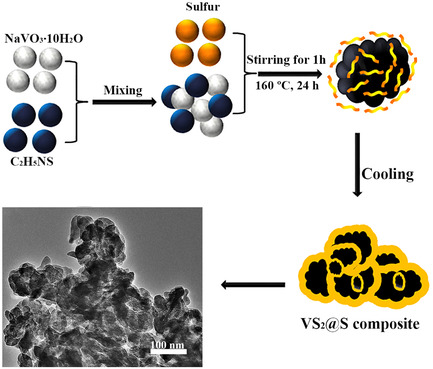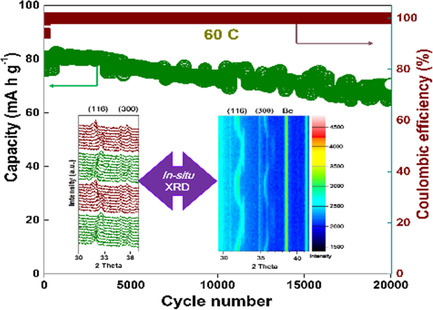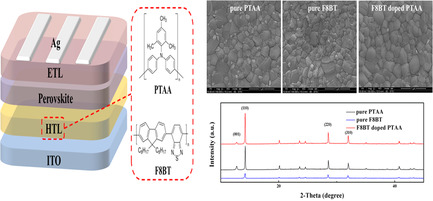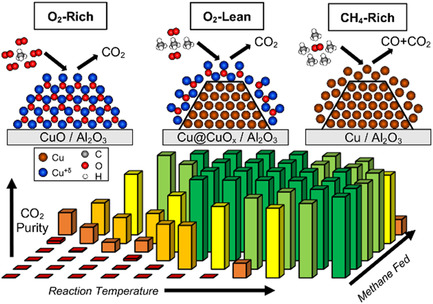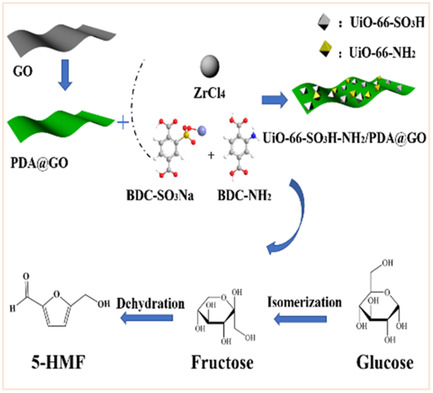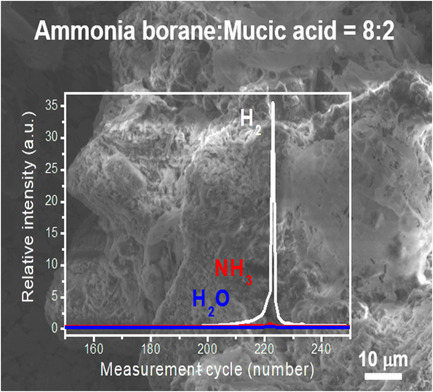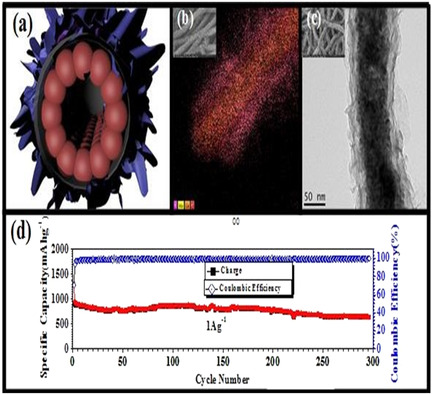Journal list menu
Export Citations
Download PDFs
Cover Picture
Core-Shell Nanoparticles with a Redox Polymer Core and a Silica Porous Shell as High-Performance Cathode Material for Lithium-Ion Batteries
- First Published: 09 March 2020
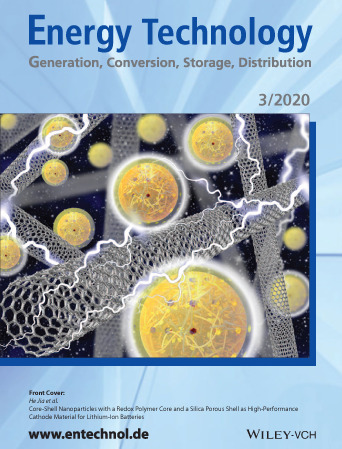
Core-shell nanoparticles are fabricated based on a redox polymer core and a porous SiO2 shell and embedded homogeneously into carbon nanotubes conductive networks. Due to the uniform dispersion of active units, the resulting free-standing composite electrode exhibits a high specific capacity at 10C and a long cycling life. More details can be found in article number 1901040 by He Jia, Jean-François Gohy, and co-workers.
Inside Front Cover
A Computational Approach toward the Enhanced Performance of Graphene–Perovskite Schottky Solar Cells
- First Published: 09 March 2020
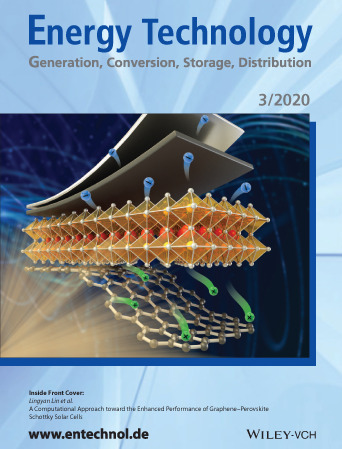
A graphene–perovskite Schottky solar cell is numerically analyzed, where the graphene serves as both a front transparent electrode for light transmission and a layer for carrier separation and collection. The influences of the parameters of graphene, perovskite, and back contact are studied to achieve optimized device performance. More details can be found in article number 1901197 by Yu Qiu and co-workers.
Inside Back cover
Pearl Necklace Fibrous Carbon Sharing Fe–N/Fe–P Dual Active Sites as Efficient Oxygen Reduction Catalyst in Broad Media and for Liquid/Solid-State Rechargeable Zn–Air Battery
- First Published: 09 March 2020
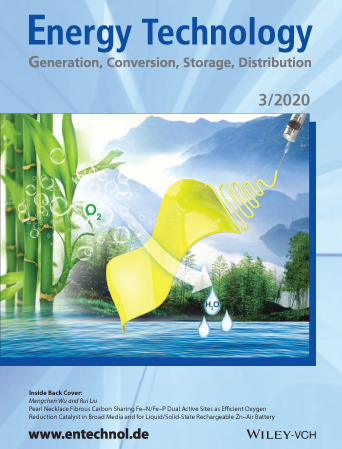
Flexible nanofiber assembled zinc–air battery: carbonization–phosphidation of metal–organic framework (MOF)/polyacrylonitrile nanofibers gives rise to a pearl necklace fibrous carbon catalyst with Fe-N/Fe-P dual active sites (Fe-P/NHCF). This strategy puts forward a protocol to develop tailored geometries with dual active sites for the oxygen reduction reaction in alkaline/acid media, which is expected to promote devices of practical significance. More details can be found in article number 1901263 by Rui Liu and Mengchen Wu.
Back Cover
A Highly Flexible Yet >300 mAh cm−3 Energy Density Lithium-Ion Battery Assembled with the Cathode of a Redox-Active Polyether Binder
- First Published: 09 March 2020

A highly flexible cathode for lithium-ion batteries is made with lithium cobalt oxide, single-walled carbon nanotubes, and a redox-active radical polymer binder. The polyether backbone of the polymer is beneficial to withstand rapid bending over 104 times. The high energy density of the hybrid cathode (> 300 mAh cm−3) contributes to the realization of a 0.5 mm thick flexible battery. More details can be found in article number 1901159 by Kenichi Oyaizu, Hiroyuki Nishide, and co-workers.
Masthead
Reviews
Recent Advances and Prospects of Metal-Based Catalysts for Oxygen Reduction Reaction
- First Published: 02 November 2019
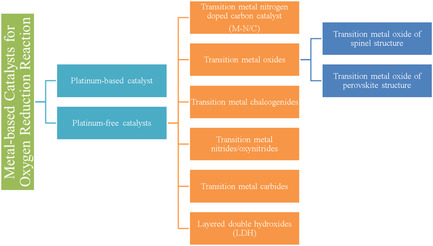
The fuel cell cathode oxygen reduction metal-based catalyst is roughly classified into a platinum-based catalyst and a platinum-free catalyst. Platinum-based catalysts are superior in performance but expensive. In recent years, various platinum-free catalysts have been developed, which not only lowers the price but also greatly improves the catalytic performance.
Microporous Solids En Route to Heterogeneous Electrocatalysis: The Oxygen Reduction Reaction
- First Published: 19 November 2019
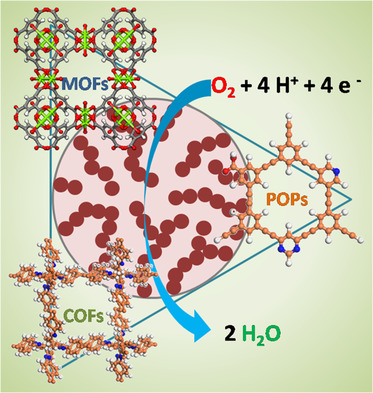
Microporous solids provide wide opportunities for heterogeneous electrocatalysis, specifically for oxygen reduction reaction (ORR), due to the diverse chemical composition, porosity, as well as physical and chemical stability. The progress made in deriving efficient ORR catalysts from microporous solids, challenges and limitations encountered, and recommendations for catalyst design and testing conditions are reviewed in attempt to outline future directions.
Advanced Nanomaterials for Nuclear Energy and Nanotechnology
- First Published: 28 November 2019
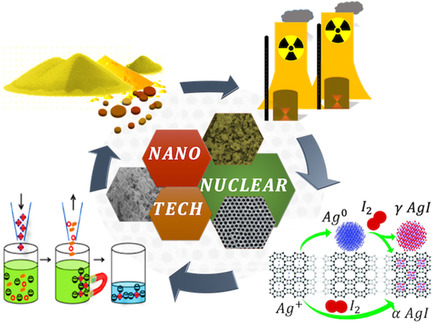
Safe nuclear energy is real! Nuclear nanotechnology (NNT) is an efficient tool and candidate for achieving the goal of overcoming challenges during nuclear energy production. NNT addresses the issues of performance and safety and reduces radiation hazard risk using advanced nanomaterials in the nuclear energy system from nanofuel production, used fuel recycling, to radiation detecting and monitoring.
A Literature Review on Methodologies of Fault Location in the Distribution System with Distributed Generation
- First Published: 13 December 2019
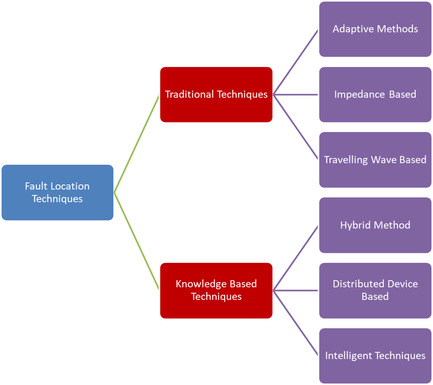
The existing fault location techniques for distribution systems with distributed generation (DG) are critically reviewed. An overview on the DG impact on distribution system protection is provided along with a comparative analysis of different approaches for fault location. Technical issues and challenges arising from DG integration are analyzed and some key issues and suggestions are provided.
Communications
A Highly Flexible Yet >300 mAh cm−3 Energy Density Lithium-Ion Battery Assembled with the Cathode of a Redox-Active Polyether Binder
- First Published: 12 November 2019
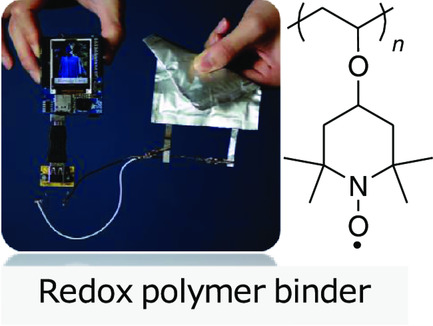
A flexible yet high-volumetric-capacity (>300 mAh cm−3) cathode is proposed for lithium-ion batteries. A redox-active polymer binder, composed of 2,2,6,6-tetramethylpiperidine 1-oxyl (TEMPO) with vinyl ether main chain, offers preferable adhesivity to conventional lithium metal oxide particles and conductive carbons. A prototype battery with a thickness of only 0.5 mm operates even under rapid bending.
Performance and Matching Band Structure Analysis of Tandem Organic Solar Cells Using Machine Learning Approaches
- First Published: 01 December 2019
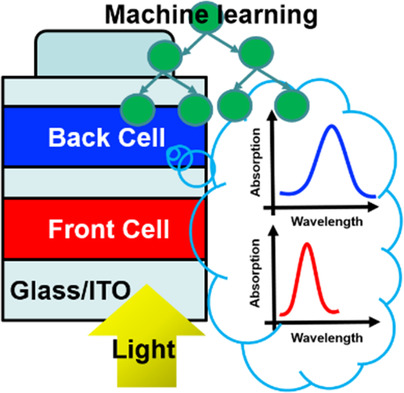
Tandem organic solar cells (OSCs) are typical multiple-layer devices. The good combination of sub-cell materials can be seen as an important factor directly affecting device performance. Herein, the machine-learning approach is used to provide more material selection flexibility and rationally optimize the device structures of tandem OSCs.
Electrode Composite for Flexible Zinc–Manganese Dioxide Batteries through In Situ Polymerization of Polymer Hydrogel
- First Published: 28 November 2019
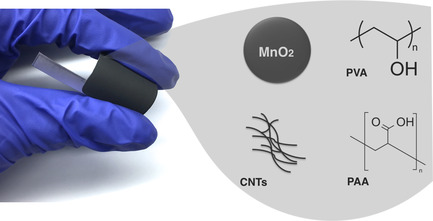
A unique approach to fabricate a mechanically robust manganese dioxide (MnO2) electrode with volumetric energy density matching that of a commercial alkaline battery is reported. A polyvinyl alcohol/polyacrylicacid gel cross-linked in situ is used as a binder for the electrode. The batteries have high volumetric energy density of 320 mWh cm−3 and retain 97% of capacity after flexing.
Organic–Inorganic Copper (II)-Based Perovskites: A Benign Approach toward Low-Toxicity and Water-Stable Light Absorbers for Photovoltaic Applications
- First Published: 22 November 2019
Synthesis of Porous Carbon Nanotubes@LiVTiO4 Composites and Their Advanced Electrochemical Properties for Lithium-Ion Batteries
- First Published: 14 January 2020
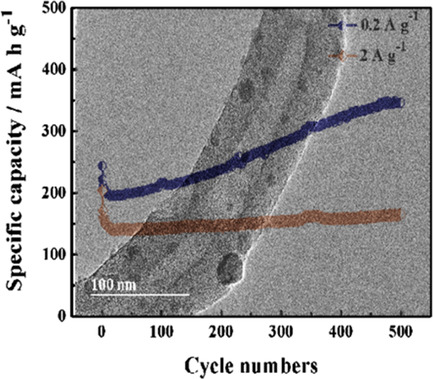
The LiVTiO4 nanoparticles are embeded into the walls of carbon nanotubes (CNTs), which can successfully prevent the agglomeration and pulverization of nanoparticles. Therefore, as an anode of lithium-ion batteries, CNT@LiVTiO4 exhibits a high capacity of 346 and 165 mAh g−1 after 500 cycles at 0.2 and 2 A g−1, good electrical conductivity, and excellent rate capacity.
Casein-Derived Activated Carbon: Turning Expired Milk into Active Material for Electrochemical Capacitors
- First Published: 21 December 2019
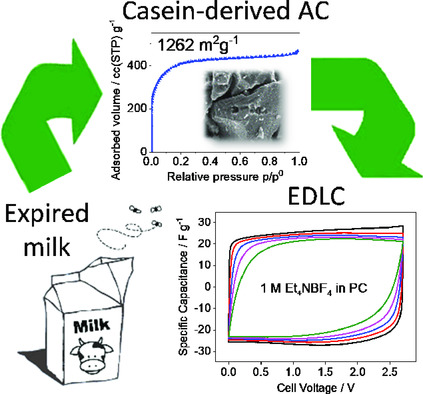
Expired milk is used as biowaste precursor for the synthesis of activated carbon (AC) for electrochemical double-layer capacitors (EDLCs). Casein is extracted, chemically activated, and carbonized. The resulting AC possesses a surface area of 1262 m2 g−1 and, in symmetric EDLCs, it displays specific capacitance values comparable with commercially available ACs (22–28 F g−1), in both conventional and innovative electrolytes.
Full Papers
Core-Shell Nanoparticles with a Redox Polymer Core and a Silica Porous Shell as High-Performance Cathode Material for Lithium-Ion Batteries
- First Published: 25 October 2019

This study discloses the fabrication of nanoparticles made of redox polymer cores surrounded by stabilizing porous silica shells, that are dispersed in a conductive net work of multi-walled carbon nanotubes. Because of their well-controlled morphology, the resulting composite electrodes exhibit a high specific capacity and a long cycling life.
A Computational Approach toward the Enhanced Performance of Graphene–Perovskite Schottky Solar Cells
- First Published: 26 November 2019
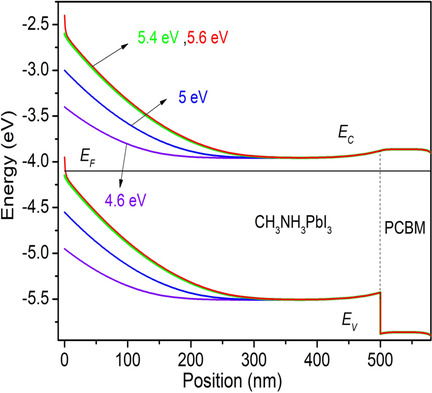
The simulation results indicate that the front contact with a high work function (WF) of 5.4 eV is suggested to form a desired Schottky junction, whereas back contact WF lower than 4.2 eV is desired to form ohmic contact. Absorber doping concentration of 1016 cm−3 favors the efficiency improvement. Under optimized conditions, efficiency up to 21.13% can be obtained.
Pearl Necklace Fibrous Carbon Sharing Fe–N/Fe–P Dual Active Sites as Efficient Oxygen Reduction Catalyst in Broad Media and for Liquid/Solid-State Rechargeable Zn–Air Battery
- First Published: 09 January 2020
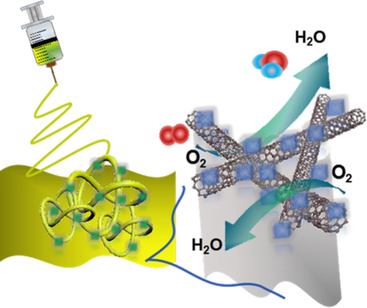
An electrospinning technique is utilized to fabricate 1D necklace-like architectures. From a carbonization–phosphidation strategy, elegantly designed Fe–N/Fe–P dual active sites are introduced into the structure, which can promote performance in oxygen reduction reaction (ORR) and liquid/solid-state Zn–air batteries.
Thermal Emission-Enhanced and Optically Modulated Radioisotope Thermophotovoltaic Generators
- First Published: 29 November 2019

Herein, the radioisotope thermophotovoltaic (RTPV) effect is studied. The thermal emission enhancement of the silicone coating is discussed, and the SiO2 filter is used to regulate the infrared radiation. The results show that the synergistic effect of the silicone coating and the SiO2 filter significantly increases the output power of the RTPV generators.
Vacuum-Dried 3D Holey Graphene Frameworks Enabling High Mass Loading and Fast Charge Transfer for Advanced Batteries
- First Published: 29 October 2019
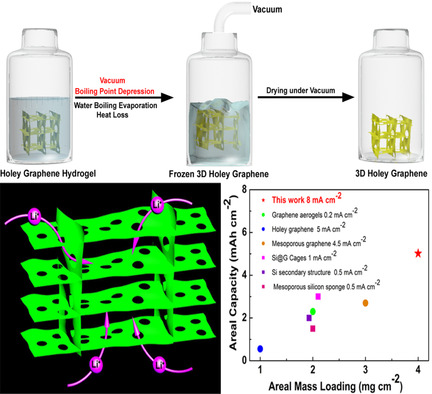
A facile vacuum-induced drying strategy is proposed to produce 3D holey graphene frameworks (HGFs) for the first time. Because of the 3D HGF facilitates ion and charge transport and efficient usage of active materials, the binder-free electrode with high mass loading exhibits superior rate performance and can deliver stable high areal capacity.
Perovskite LaNiO3 Nanocrystals inside Mesostructured Cellular Foam Silica: High Catalytic Activity and Stability for CO2 Methanation
- First Published: 08 January 2020
Thermodynamic Analysis of High-Temperature Energy Storage Concepts Based on Liquid Metal Technology
- First Published: 29 October 2019
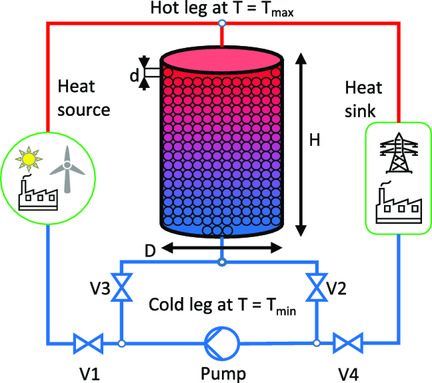
Herein, technical concepts for using liquid metal technology in innovative high-temperature thermal energy storage (TES) systems are dealt with. Optimization strategies are presented for a reference case including transient behavior of the whole system. The sensitivity of multiple parameters, e.g., porosity, particle size, and influence of storage capacity regarding the discharge efficiency, is investigated.
Thermodynamic Analysis of High-Temperature Carnot Battery Concepts
- First Published: 09 October 2019
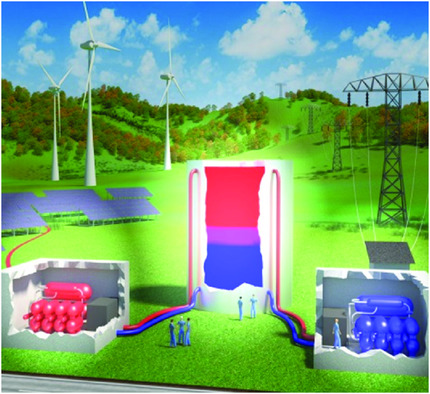
Carnot batteries are an emerging alternative concept for storing electric energy based on the combination of heat storage systems and thermodynamic cycles. Herein, an analysis of various concepts for the implementation of pumped thermal energy storage (PTES) is provided, which is a Carnot battery concept using heat pumps to charge the heat storage.
X-Ray-Computed Radiography and Tomography Study of Electrolyte Invasion and Distribution inside Pristine and Heat-Treated Carbon Felts for Redox Flow Batteries
- First Published: 29 October 2019
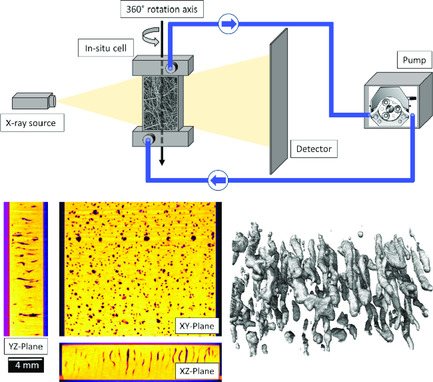
Electrolyte wetting of various carbon felt electrodes for utilization in redox flow batteries is investigated using X-ray computed radiography and tomography. The wetting behavior shows no significant improvement by heat treatment, which gives reason to rethink the hitherto frequently drawn conclusions regarding the correlation between improved wetting behavior and enhanced electrode performance.
A Microtubular Direct Carbon Solid Oxide Fuel Cell Operated on the Biochar Derived from Pepper Straw
- First Published: 29 October 2019
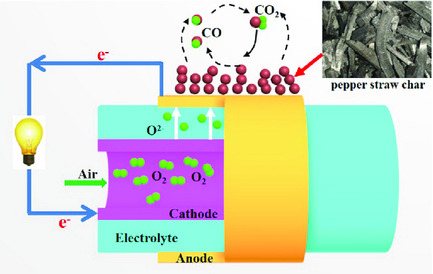
The biochar derived from pepper straw is proved to be a superior energy source for microtubular direct carbon–solid oxide fuel cell (DC–SOFC) due to the naturally existing catalysts in fuel itself. Based on the results, it is valuable for developing microtubular DC–SOFC into a safe, effective, and environment-friendly distributed power-generation system using local biomass as fuel.
Inkjet Printing of Li-Rich Cathode Material for Thin-Film Lithium-Ion Microbatteries
- First Published: 24 October 2019
Formation of Nitrogen-Doped Carbon-Coated CoP Nanoparticles Embedded within Graphene Oxide for Lithium-Ion Batteries Anode
- First Published: 02 November 2019
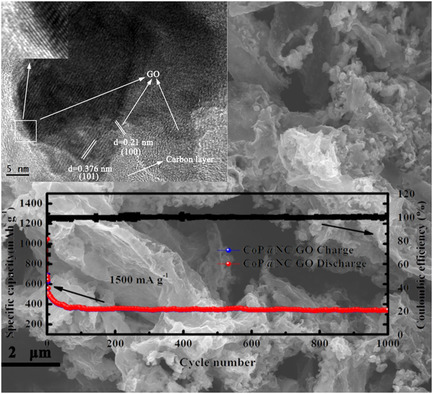
CoP nanoparticles are synthesized using metal–organic frameworks-Co as templates. The CoP nanoparticles coated with N-doped carbon are homogeneously embedded into the graphene network which can effectively provide highly efficient pathways for electrons/ions and buffer the volume expansion. The hybrid electrode delivers a high reversible capacity at a high current density of 1500 mA h g−1.
Sulfated Zirconia with Different Crystal Phases for the Production of Ethyl Levulinate and 5-Hydroxymethylfurfural
- First Published: 12 November 2019
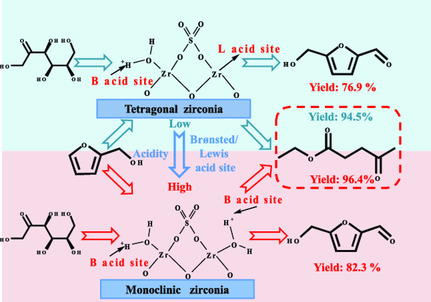
Sulfated zirconia with different crystal phases is achieved for the production of ethyl levulinate and 5-hydroxymethylfurfural, and the sulfated zirconia of monoclinic phase contains more abundant acidic sites and more Brønsted acid sites than that of sulfated zirconia of tetragonal phase, showing excellent catalytic activity for conversion of furfuryl alcohol and conversion of fructose.
In Situ Construction of Multibuffer Structure 3D CoSn@SnOx/CoOx@C Anode Material for Ultralong Life Lithium Storage
- First Published: 08 October 2019
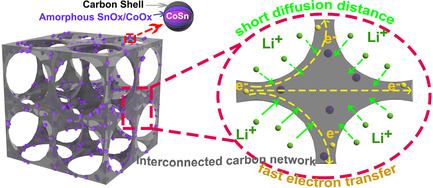
A multibuffer structure of 3D CoSn@SnOx/CoOx@C is successfully synthesized by a facile NaCl template-assisted in situ catalytic strategy, and used as the anode material of lithium-ion batteries. Benefiting from a unique structure, the as-prepared 3D CoSn@SnOx/CoOx@C delivers an excellent electrochemical performance (almost no capacity decay at 10 A g−1 after 1000 cycles).
Lamellar V5O12·6H2O Nanobelts Coupled with Inert Zn(OH)2·0.5H2O as Cathode for Aqueous Zn2+/Nonaqueous Na+ Storage Applications
- First Published: 13 November 2019

Z-V5O12·6H2O nanobelts with dual-phase structures are fabricated and applied as cathodes for aqueous Zn-ion batteries (ZIB) and nonaqueous Na-ion batteries (SIB). Due to good buffer action of inert Zn(OH)2·0.5H2O and large interlayer distance of active V5O12·6H2O, the lamellar Z-V5O12·6H2O composites exhibit good structural stability and enhanced electrochemical properties for Zn2+/Na+ storage.
Impact of Residual Lead Iodide on Photophysical Properties of Lead Triiodide Perovskite Solar Cells
- First Published: 11 November 2019
Positive-Temperature-Coefficient Graphite Anode as a Thermal Runaway Firewall to Improve the Safety of LiCoO2/Graphite Batteries under Abusive Conditions
- First Published: 14 November 2019
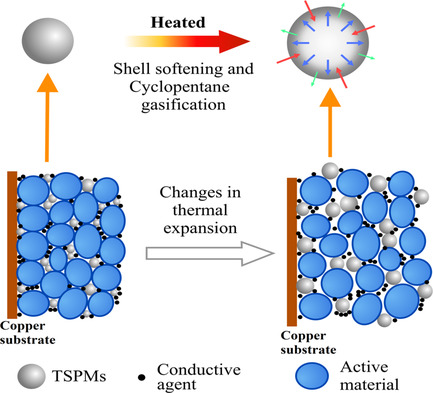
Due to the thermally sensitive properties of TSPMs in the graphite anode of LiCoO2/graphite lithium-ion batteries (LIBs), the graphite anode swells to cut off the electric connection of active materials and current collector under abusive conditions. Thus, the resistance of LIBs is increased to solve the thermal runaway and safety problems before the temperature of LIBs approaches explosion limit.
Tailored Synthesis of Coral-Like CoTiO3/Co3O4/TiO2 Nanobelts with Superior Lithium Storage Capability
- First Published: 13 November 2019
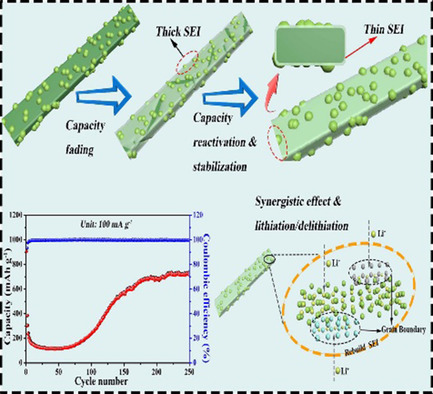
The coral-like hybrid nanobelts are fabricated via an electrospinning method following thermal treatment. And the long cycle and good reversibility performance of hybrid nanobelt electrodes are attributed to self-optimization of the solid electrolyte interface (SEI) layer and synergistic effect of different compositions.
Evaluation and Improvement of Energy Utilization Efficiency in Typical Iron and Steel Smelting Route Based on Input-Use-End Model
- First Published: 04 December 2019
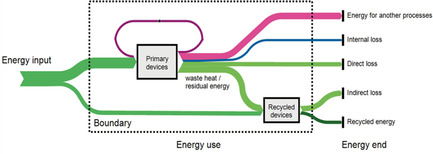
By establishing an input-use-end model, a new index is put forward herein to evaluate energy utilization of the iron and steel smelting route—energy utilization efficiency. Furthermore, energy utilization efficiency of a typical iron and steel smelting route is analyzed and improved based on the established network diagram.
Tetrahydrofuran as an Oxygen Donor Additive to Enhance Stability and Reproducibility of Perovskite Solar Cells Fabricated in High Relative Humidity (50%) Atmosphere
- First Published: 22 November 2019

In the sequential deposition method of perovskite, the PbI2 layer morphology plays an essential role in enhancing power conversion efficiency (PCE) of perovskite solar cells. Herein, investigation on the effect of incorporation of tetrahydrofuran (THF) additive to tune the PbI2 morphology under ≈50% relative humidity is presented. The device fabricated from resulting perovskites elucidates reproducible and improved PCE and stability.
Improved Performance and Immobilizing Mechanism of N-doping Carbon Aerogel with Net Channel via Long-Chain Directing for Lithium–Sulfur Battery
- First Published: 27 November 2019
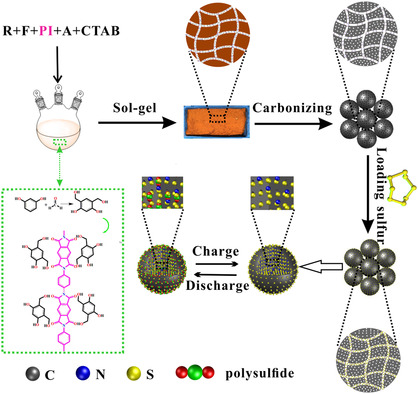
The novel net channel and N-doping carbon aerogel are successfully prepared by facile method via polyimide (PI) inducting as a cathode matrix for Li–S batteries. The PI-CA/S composites present excellent electrochemical performance due to the net structure and N-doping. Furthermore, the theoretical calculation by density functional theory (DFT) supports the template effect of PI and the anchoring mechanism of polysulfides.
Bi-Metal (Zn, Mn) Metal–Organic Framework–Derived ZnMnO3 Micro-Sheets Wrapped Uniformly with Polypyrrole Conductive Network toward High-Performance Li-Ion Batteries
- First Published: 29 November 2019
NaCl-Templated and Polyvinylpyrrolidone-Assisted Fabrication of a MnO/C-rGO Composite as a High-Capacity Anode Material for Li-Ion Batteries
- First Published: 02 December 2019
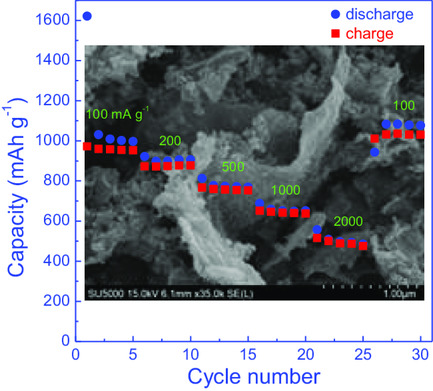
A MnO/pyrolytic carbon and reduced graphene oxide composite (MnO/PC-rGO) with a 3D hierarchical heterostructure is synthesized. The MnO nanoparticles are well distributed on the surface of PC-rGO. This composite exhibits a high specific capacity of 1030 mAh g−1 at 100 mA g−1 as an anode for Li-ion batteries. The Li-storage performance is much superior to that of the MnO/PC composite prepared under similar conditions.
Pressure-Induced Synthesis of Homogeneously Dispersed Sn/SnO2/C Nanocomposites as Advanced Anodes for Lithium-Ion Batteries
- First Published: 05 December 2019
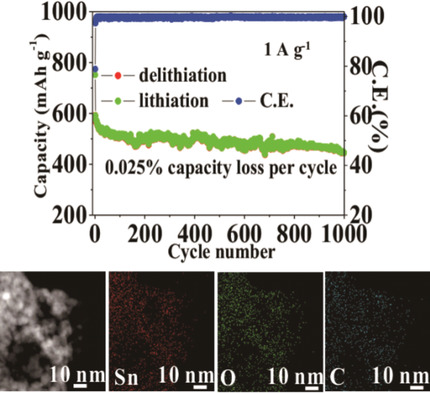
Sn/SnO2/C nanocomposites consisting of homogeneously dispersed Sn, SnO2, and C phases are prepared by high pressure caused by pyrolysis of C2H6OSn in a sealed vessel. As anodes for lithium-ion batteries, the Sn/SnO2/C nanocomposites exhibit excellent cycling stability (0.025% capacity loss per cycle upon 1000 cycles) and improved rate performance (243.8 mAh g−1 at 5 A g−1).
Sustainable Porous Carbon with High Specific Surface Area from Soybean Shell via Hydrothermal Carbonization with H3PO4 for Electric Double-Layer Capacitor Applications
- First Published: 30 October 2019
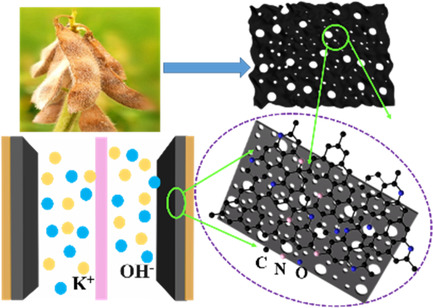
Soybean shell, as the byproduct of soybeans, is converted into porous carbon (PC) with a high specific surface area via hydrothermal carbonization with H3PO4 followed by KOH activation. PC as the electrode for an electric double-layer capacitor shows good electrochemical performance and an excellent cycling stability in a two-electrode system in 6 m KOH electrolyte.
Transient Flow Rate Ramps for Methanation of Carbon Dioxide in an Adiabatic Fixed-Bed Recycle Reactor
- First Published: 01 November 2019
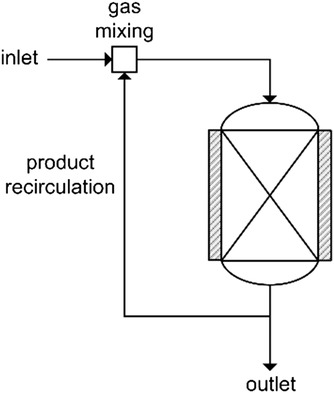
The power-to-gas (PtG) process enables the long-term indirect storage of electrical energy. The dynamic operation of methanation reactors is favored, but not fully understood thus far. Therefore, this contribution investigates the dynamic operation of a fixed-bed recycle reactor during flow rate ramps with a variation of ramp time and recycle ratio.
An Aqueous Battery–Pseudocapacitor Hybrid Capacitor Based on Conductive Core–Shell NiCoSe2@Co9Se8 Hollow Nanospheres Hybridized with Nanoscale Ru0.41In0.59Oy
- First Published: 06 December 2019
Facile Synthesis of Flock-Like V2O3/C with Improved Electrochemical Performance as an Anode Material for Li-Ion Batteries
- First Published: 07 December 2019
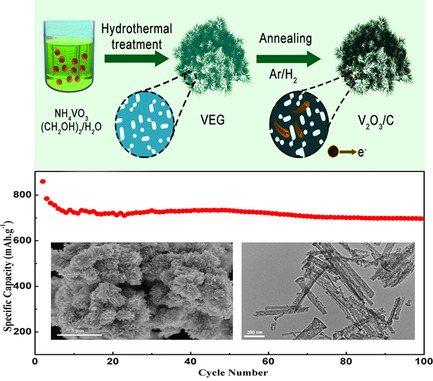
Flock-like V2O3 coated with carbon (V2O3/C) is prepared by a facile solvothermal method followed by treatment at a relatively low temperature. The unique structure and morphology bring excellent cyclic stability and rate capability for V2O3/C. The outstanding electrochemical performance reveals its great potential as an anode material for Li-ion batteries.
Novel Sepiolite-Based Materials for Lithium- and Sodium-Ion Storage
- First Published: 12 December 2019
Vanadium Sulfide@Sulfur Composites as High-Performance Cathode for Advanced Lithium–Sulfur Batteries
- First Published: 13 December 2019
Flexible Piezoelectric Nanofibers/Polydimethylsiloxane-Based Pressure Sensor for Self-Powered Human Motion Monitoring
- First Published: 13 January 2020
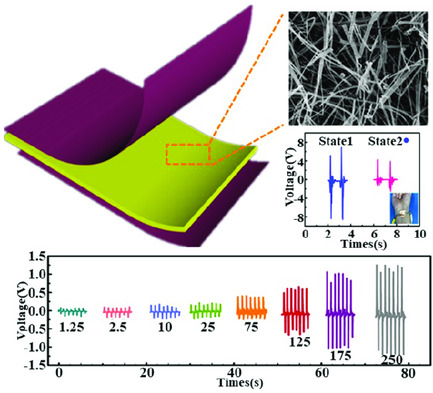
A flexible piezoelectric sensor composed of a lead zirconate titanate (PZT) nanofibers/polydimethylsiloxane (PDMS) piezoelectric composite layer and two magnetron-sputtered copper (Cu) electrode layers is proposed. The sensor has good flexibility, extensibility, and adapts perfectly to the surface topography of the body without external power supply. It fulfills the requirements for human motion monitoring.
Transient Analysis of a Current-Driven Full Wave AC/DC Converter for Indirect Characterization of Piezoelectric Devices during Energy Harvesting
- First Published: 17 January 2020
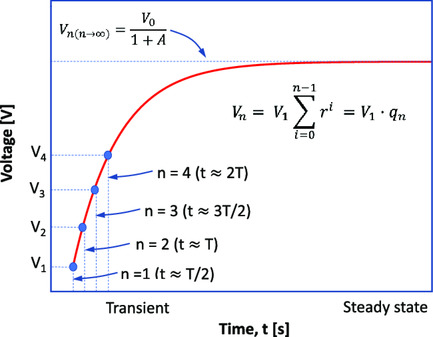
A new expression for the development of the output voltage with time of a piezoelectric energy harvester is presented. This enables a novel approach to measure indirectly the driving current (related to the piezoelectric coefficients) and the device capacitance (related to material permittivity) at the frequency, temperature, stress, and strain experienced by the energy harvester during operation.
A Sodium Polysulfide Battery with Liquid/Solid Electrolyte: Improving Sulfur Utilization Using P2S5 as Additive and Tetramethylurea as Catholyte Solvent
- First Published: 12 December 2019

A Na/polysulfide cell concept with two electrolyte chambers separated by Na-β″-aluminate is discussed. The concept allows tailoring of the electrolyte formulation for both half reactions. For the positive electrode, sulfide precipitation is effectively mitigated using P2S5 as an additive, and cycle life is improved using tetramethylurea (TMU) as a solvent. This proof-of-concept study could be interesting for developing stationary energy stores.
Carbon-Coated Na3V2(PO4)3 Supported on Multiwalled Carbon Nanotubes for Half-/Full-Cell Sodium-Ion Batteries
- First Published: 15 November 2019
A MXene-Coated Activated Carbon Cloth for Flexible Solid-State Supercapacitor
- First Published: 17 December 2019
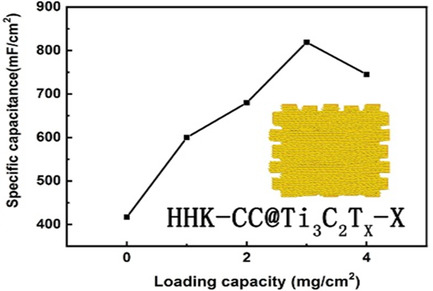
A new composite electrode using Ti3C2TX flakes coating on activated carbon cloth for flexible solid-state supercapacitors is prepared. At the optimal load of 3 mg cm−2, the prepared electrode achieves a high capacitance of 1033 mF cm−2 at the current density of 1 mA cm−2. The capacitance value remains 97.6% after 10 000 cycles in a three-electrode system.
Efficiency Improvement of Planar Inverted Perovskite Solar Cells by Introducing Poly 9,9-Dioctyfluorene-co-benzothiazole into Polytriarylamine as Mixed Hole-Transport Layer
- First Published: 21 December 2019
Solid versus Liquid—A Bottom-Up Calculation Model to Analyze the Manufacturing Cost of Future High-Energy Batteries
- First Published: 04 January 2020
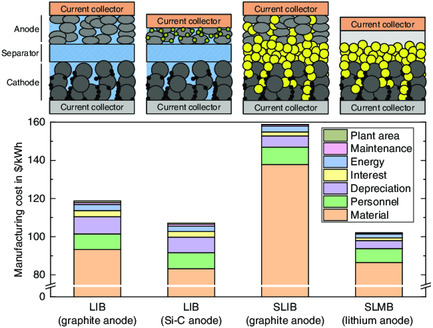
The manufacturing cost of all-solid-state batteries is systematically compared with conventional lithium-ion battery production. The bottom-up calculation enables an investigation of different anode and solid electrolyte materials, as well as the corresponding production technologies from an economic perspective. Hence, critical process steps are identified to facilitate decision making during scale-up toward industrial production.
A 3D Carbon Foam Derived from Phenol Resin via CsCl Soft-Templating Approach for High-Performance Supercapacitor
- First Published: 07 January 2020

3D carbon foam, with carbon nanorods as the skeleton crossed by graphene nanosheets, is harvested via carbonizing low-molecular-weight phenolic resin in the presence of a CsCl salt template. It possesses high specific surface area, abundant porous structure, and great electric conductivity, and exhibits superior electrochemical performance in a coin-type symmetric supercapacitor in 6 m KOH and 1 m TEABF4/MeCN.
Selective Reduction of Oxygen on Non-Noble Metal Copper Nanocatalysts
- First Published: 03 January 2020
Electricity Arbitration and Sector Coupling with an Experimentally Validated Reversible Solid Oxide Cell Reactor System Connected to the Natural Gas Grid
- First Published: 04 January 2020
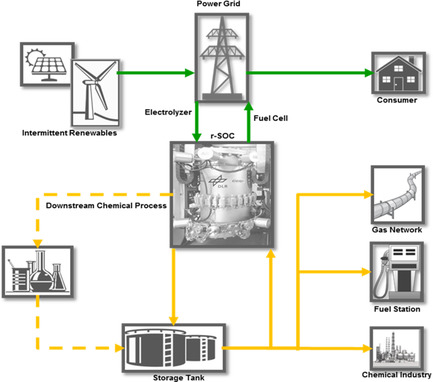
A unitized system based on a reversible solid oxide cell electrochemical reactor system coupled with a downstream methanation process is proposed. It produces synthetic methane which is supplied to the natural gas grid when renewable electricity storage is required and utilizes methane from the natural gas grid to produce electricity when electricity price is higher and there is no demand for methane.
Energy Harvesting and Storage by Water Infiltration of Eggshell Membrane
- First Published: 04 January 2020
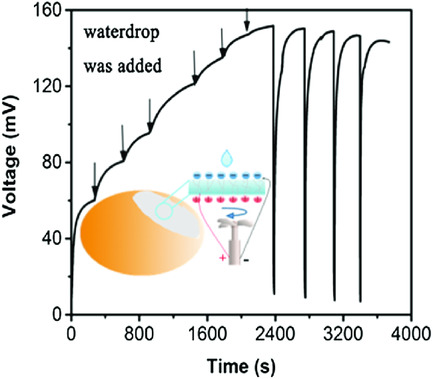
While harvesting the electrical energy from the osmosis of liquid to the eggshell membrane, the energy can be stored directly and the device can achieve discharging and recovering circularly. Sufficiently high electric output up to 0.26 V can be achieved by a single unsealed device. These devices are promising as an ideal power supply to medical implant devices.
Long-Life Sodium Metal Anodes Achieved by Cuprous Oxide–Modified Ni Foam Host
- First Published: 11 January 2020

Nanoflowered cuprous oxide–modified nickel foam (NF) is fabricated through a facile displacement reaction in aqueous solution. The tailored Cu2O on a NF skeleton can react with Na+, which is helpful to reduce the nucleation energy of Na metal in the plating process, resulting in the homogeneous nucleation of Na on the NF skeleton.
Fabrication of Graphene Oxide Supported Acid–Base Bifunctional Metal–Organic Frameworks as Efficient Catalyst for Glucose to 5-Hydroxymethylfurfural Conversion
- First Published: 09 January 2020
Sugar Acid–Assisted Thermolysis of All-Solid-State Ammonia Borane Hydrogen Fuel
- First Published: 08 January 2020
Reversible High Capacity and Reaction Mechanism of Cr2(NCN)3 Negative Electrodes for Li-Ion Batteries
- First Published: 09 January 2020
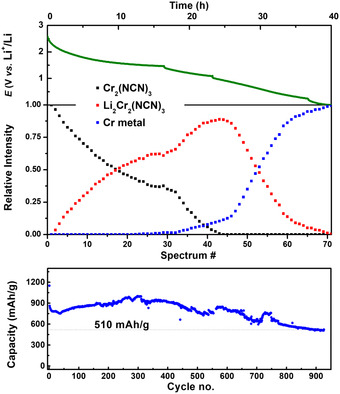
The electrochemical lithiation/delithiation mechanism of Cr2(NCN)3, studied by complementary operando analyses and density functional theory (DFT) calculations, follows a two-step reaction pathway, implying a typical conversion reaction preceded by a preliminary intercalation step. This mechanism, evidenced for the first time in transition-metal carbodiimides, is likely behind its outstanding electrochemical cycling performance as a negative electrode in Li-ion batteries.
Passive Direct Methanol–Hydrogen Peroxide Fuel Cell with Reduced Graphene Oxide–Supported Prussian Blue as Catalyst
- First Published: 09 January 2020
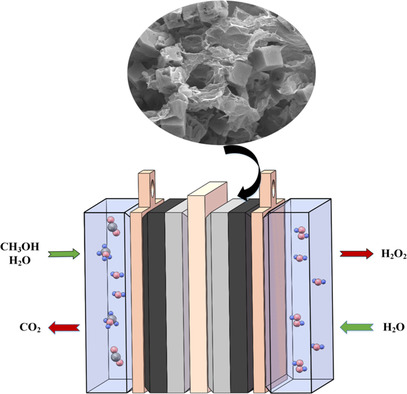
Herein, a passive direct methanol–hydrogen peroxide fuel cell is developed and the use of nanocube Prussian Blue crystals coated upon reduced graphene oxide as the cathode catalyst made by the low-temperature hydrothermal method is validated. Due to the high catalytic activity of the catalyst with a unique 3D conductive structure, the fuel cell shows an excellent overall performance.
Lignin-Derived Hard Carbon Microspheres Synthesized via Emulsion-Solvent Evaporation as Anode for Sodium Storage
- First Published: 08 January 2020

Lignin-derived carbon microspheres are synthesized via an emulsion-solvent evaporation method. The addition of amphiphilic carbonaceous materials (ACMs) has an influence on the microstructure and thermal stability of as-obtained carbon microspheres. Consequently, the electrochemical properties are improved when used as an anode in sodium-ion batteries. The samples achieve a high initial efficiency, good rate performance, and enhanced cyclic stability.
CoP/N-Doped Carbon Nanowire Derived from Co-Based Coordination Polymer as Efficient Electrocatalyst toward Oxygen Evolution Reaction
- First Published: 09 January 2020

CoP/N-doped carbon (CoP/NC) nanowires are prepared using a coordination polymer [Co(C4H7NO4)]·xH2O (Co-Asp) nanowire as the template through simultaneous pyrolysis and low-temperature phosphidation. The CoP/NC-400 nanowire has high electrochemical surface area due to the strong synergistic effect of the CoP nanoparticle and N-doped carbon nanowire.
Template-Free Synthesis of Hierarchical Composite Nanotubes with Superior Lithium and Sodium Storage Performance
- First Published: 14 January 2020
Porous Titanium Oxide Microspheres as Promising Catalyst for Lithium–Oxygen Batteries
- First Published: 03 February 2020
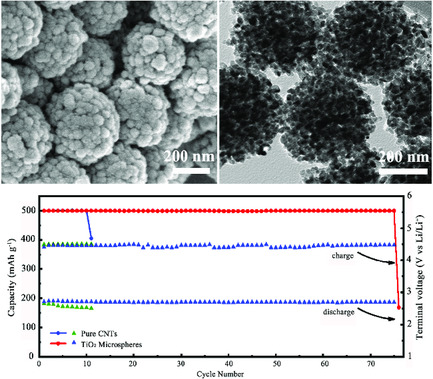
Small particle-stacked TiO2 microspheres are successfully synthesized, which provide 3D framework with more catalytically active sites and rich porosity for the storage of discharge products and oxygen diffusion. Li–O2 batteries utilizing the TiO2 microspheres show a much higher specific capacity and a lower overpotential than those with pure carbon nanotube (CNT).





